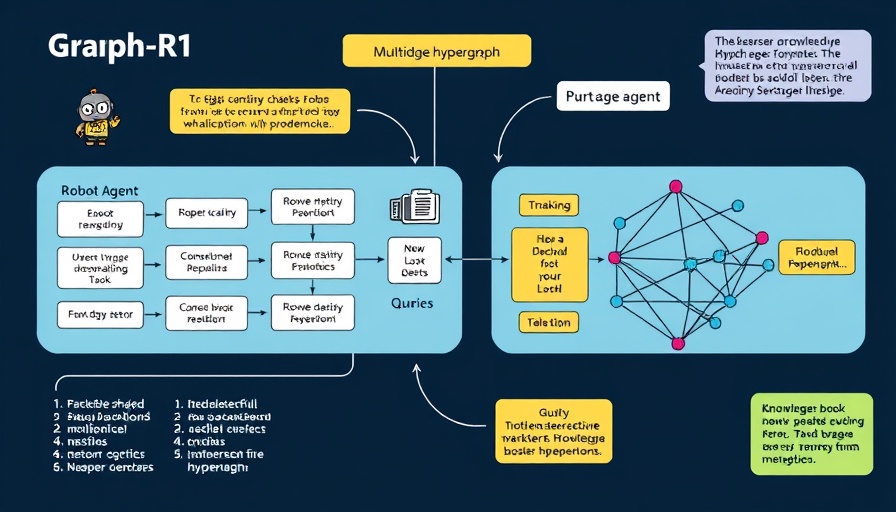
Revolutionizing Reasoning with Graph-R1
As businesses navigate an increasingly digital landscape, staying ahead means embracing cutting-edge technology. One of the latest advancements in artificial intelligence (AI) is the Graph-R1 framework, which elevates the capabilities of large language models (LLMs) by enhancing their reasoning processes. Introduced by researchers from Nanyang Technological University, National University of Singapore, Beijing Institute of Computer Technology and Application, and Beijing Anzhen Hospital, Graph-R1 utilizes an agentic Graph Retrieval-Augmented Generation (GraphRAG) framework to enable structured multi-turn reasoning through reinforcement learning. This innovative approach is not just a technical enhancement; it holds considerable implications for small and medium-sized businesses looking to leverage AI for better decision-making and operational efficiency.
Understanding the Power of Structured Reasoning
The transition to digital communication booms requires businesses to adapt rapidly, and advanced AI systems have a crucial role to play. Traditional RAG frameworks, while useful, often fall short in representing complex semantic relationships. Graph-R1 changes the game by constructing knowledge as a hypergraph, allowing for richer and more nuanced interactions that facilitate dynamic reasoning. This means that AI can partake in multi-turn conversations, adapting to new information and refining its responses rather than relying solely on static responses.
Imagine using Graph-R1 in your business operations—whether for customer service, data analysis, or content creation. The ability to follow up on inquiries and adapt answers in real-time can transform interactions and lead to better customer satisfaction and engagement.
The Practical Benefits of Graph-R1 for Businesses
For small and medium-sized businesses, the integration of Graph-R1 into AI-driven applications poses numerous advantages:
- Cost Efficiency: Graph-R1 boasts a remarkable construction cost of $2.81 per 1,000 tokens, offering a more economical alternative to existing models like GraphRAG which averages $3.35. By streamlining the knowledge construction process, your business can allocate resources more effectively.
- Enhanced Decision-Making: With its end-to-end reinforcement learning approach, Graph-R1 rewards systems that prioritize structural coherence and semantic accuracy. This feature helps businesses make informed decisions backed by a solid framework, reducing the risk of errors that could stem from inaccurate data interpretation.
- Adaptive Learning: The multi-turn agentic retrieval process allows businesses to adapt their queries dynamically. This means an AI can engage in back-and-forth conversations, leading to a deeper understanding of complex inquiries.
Unlocking the Future of AI-assisted Business
As Graph-R1 sets new benchmarks in AI technology, it's not just about capabilities—it's about the future landscape of business applications. With the innate ability to handle multi-turn dialogues and intricate reasoning, businesses can anticipate a rise in user-friendly AI applications that cater to diverse functions, from customer support to strategic decision-making. The implications for productivity and efficiency are profound, positioning AI as a key player in modern business operations.
Visualizing the Success of Graph-R1
Picture a customer service scenario where a Chatbot powered by Graph-R1 doesn’t just provide straightforward answers based on predetermined scripts. Instead, this AI can analyze customer intent, respond consistently while taking context into account, and refine its responses based on ongoing dialogues. This capability not only enhances user experience but also builds trust and fosters stronger customer relationships.
Engaging with the Future: Actions for SMBs
To harness the potential of frameworks like Graph-R1, small and medium-sized businesses should consider integrating AI into their operations. Whether through personalized marketing strategies or automated customer interactions, now is the time to explore how intelligent systems can improve engagement and boost growth. As AI technologies advance, adapting and implementing these breakthroughs can lead to transformative outcomes for your business.
In conclusion, as AI continues its evolution, staying informed about frameworks like Graph-R1 can empower decision-makers in small and medium-sized businesses to leverage this technology effectively. Embracing these advancements isn’t just a beneficial strategy; it’s crucial for competitiveness in the marketplace. Start exploring how you can implement AI solutions today, and empower your business for a prosperous future.
 Add Row
Add Row  Add
Add 



Write A Comment